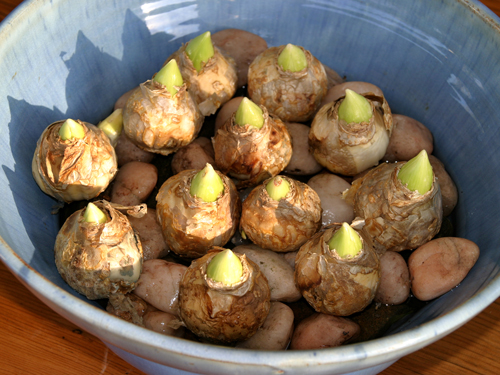No space in the garden for bulbs or no garden at all? This year grow hyacinths on water in a beautiful bowl and fill your home with their glorious scent
WHAT YOU’LL NEED:
- Bulbs. Note not all bulbs can be grown using this method; the best results are obtained from paperwhites and hyacinths.
- A bowl; this can be either ceramic or glass (if you like to see the roots develop).
- A medium such as pebbles, marbles, stones or gravel that the bulbs can sit comfortably on without toppling over.
HOW TO GROW HYACINTHS HYDROPONICALLY IN FIVE EASY STEPS:
- Fill the bottom of the container with gravel, pebbles, marbles or stones to a level of around 10cm.
- Place the bulbs on the pebbles making sure that they are upright and won’t topple over. Always place bulbs with the green tip pointing upwards.
- Fill the bowl with water to just below the bottom of the bulbs. It’s important to make sure the bulbs themselves are kept clear of the water, as prolonged contact can result in rotting. Don’t worry; the bulbs will make sure that their roots find their way down into the life-giving liquid.
- To help stimulate root development, keep the bulbs in their bowl in a dark cupboard for two weeks. Once the roots have found the water, you can bring the container out into the open. Hyacinths and paperwhites prefer a position with plenty of light, but with little or no direct sunlight. Choose a cool spot as excessive heat will inhibit growth, so don’t display your living arrangement near heaters or heat-reflecting walls. A south-facing windowsill is ideal.
- Top up the water as it evaporates making sure that the surface of the water doesn’t touch the bulbs. If planted in late April, your hyacinths will be producing blooms and filling your home with their gorgeous spring scent in about three to four months.
PROBLEM SOLVING
If the water under the bulbs turns green and gives off a slight smell, add a specialised cut-flower food like Chrysal which is available from florists. This not only checks bacterial growth that makes the water unsightly, it also adds nutrients to the water, helping to ensure peak flowering. Alternatively you can replace the water when necessary.


